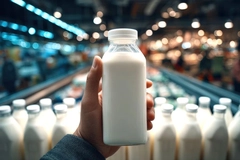Confectionery: Packaging must be in Tune with the Mood of the Moment

Changed circumstances such as the breaking up of fixed daily structures, the separation between living and workplace, the wide choice of leisure activities on offer and higher mobility have had an impact on the way consumers eat their food. Confectionery suppliers respond to these altered consumption habits by launching products that come in bite-sized portions or in small or individual packaging.
19/10/05 Regular meals – dinner when Mum calls – have now become a thing of the past. More and more people satisfy their hunger “on the go”: eating is done while walking, driving and watching TV. Changed circumstances such as the breaking up of fixed daily structures, the separation between living and workplace, the wide choice of leisure activities on offer and higher mobility have certainly had an impact on the way consumers eat their food. To compensate for the stresses of the rat race, and as an alternative to fast food, today’s consumers also consciously go for something special every now and then – a treat for themselves.
These social changes have been apparent for quite some time. They provide opportunities for industries such as confectionery to satisfy consumers’ needs and desires with trendy product innovations.
Confectionery suppliers respond to these altered consumption habits by launching products that come in bite-sized portions or in small or individual packaging. And business is booming: consumers go for these “mini sweets” if only to treat themselves to that little “delight in-between meals” or to satisfy their hunger with a “snack between meals”.
A closer look at these mini sweets confirms that product innovations in the luxury goods industry are often packaging innovations. For “minis”, existing products are frequently only scaled down and wrapped in special packaging. And most of the time, the latter decides on the market success of the product. On the one hand, packaging has to clearly distinguish the “minis” from their big brothers – of prime importance is the need to clearly communicate the added value of being able to eat on the move. On the other, differences must not be too big: after all, minis are to benefit from the brand image of the original product. Above and beyond, these smaller packaging units - not least developed for eating “on the go” - must also offer convenience. interpack 2005, to be staged in Düsseldorf from 21 to 27 April, will once again showcase convenience innovations that respond to the lifestyles of consumers always on the run. One thing is for sure – if there’s anything those mobile eaters don’t want, it’s tearing, biting, pulling and struggling to open those minis to get to their contents. Examples will show that the packaging sector can meet with these expectations regardless of the packaging material used.
A case in point is a Swiss chocolate with the revealing add on “choc ’n’ go“ showing what convenience and product differentiation are all about. This chocolate product is indeed offered in the 100 gram size typical of slab chocolate but not as a one-piece flat slab but in the shape of eight round, bit-sized sticks. They come in individual flow packs with a one-pull opening. A folding box shaped a little like a packet of cigarettes serves as secondary packaging. It is handy, sturdy and easy to open and close. The case-type packaging clearly communicates that it contains an “on-the-go” product whereas the brand-specific colouring and design signals just as unambiguously who produced this chocolate.
The trend towards miniature packaging has not even spared such confectionery classics as gummi bears. The mini package of these confectionery bears has even undergone a packaging re-launch. Instead of mini, flat oblong plastic bags the product is now offered in small tetrahedron-shaped sachets. Packaging material and filling volume remain unchanged but the new packaging looks better, is sturdier and more spectacular to open: simply press the bag with one hand in a strong and rapid grip and it will burst open at the welded seam with an audible bang.
Sandwich biscuits with chocolate filling are another confectionery classic and used to be retailed in rolls. Now this product is also available as a pocket-sized version. Two sandwich cookies are sealed in an oblong bag for snacks in-between meals and on-the-go. Portioned this way they now also ideal for popping into pockets or school bags. Eight of these portioned 31 gram packs come in a folding box.
But today’s consumers, who have embraced handy, bite-sized tidbits for in-between meals, are just as open to leisure and luxury. This implies that they deliberately “pamper” themselves now and then and treat themselves to sweets formerly only bought as give-aways such as individual chocolates or specialty bakery produce. As with minis the confectionery industry here also deems packaging the trump card for innovations in this segment.
One example of this approach are individual chocolates with a touch of wild poppy seed in the filling and packaging reminiscent of a poppy flower. This octagonal slip lid box is lavishly printed with poppy flowers and when flipping off the lid the side walls of the box slightly bend outwards so that the box basically “unfolds” like a bouquet of poppy flowers. All the more as the 15 pieces inside the box look just like those red flowers. They are individually wrapped in poppy-red twist films arranged in such a way that they resemble flower petals. Another special feature: stripping the flowers you reveal a chocolate shaped like a poppy seed capsule. Each box contains 150 grams of chocolates.
It was also not by coincidence that for another individual chocolate innovation in the “treat-yourself” segment the shape of an elegant little handbag was chosen. The elegantly rounded folding box in cardboard contains individual chocolates addressing a target group with an inclination to sweet treats. The elaborate finish of the packaging – a six-colour print, 2-layer varnish plus a relief embossing in gold – sends out an up-market message. The handbag shape says: I fit every handbag. Here packaging skilfully merges the two trends of on-the-go and treat-yourself confectionery.
Materials, however, also provide scope here. “Treat yourself” products are particularly suitable for transparent and semi-transparent plastic packaging – gaining in importance as an alternative over the past two to three years. This is why 16 melt-in-the-mouth chocolates under the product name “Femina“ are now offered in a semi-transparent PET folding box. The rectangular box features slightly slanted walls and a multi-coloured print. The units are placed into two see-through, deep-drawn PET trays. Even the separation layers consist of deep-drawn, transparent PET. The material combination comprising transparent and semi-transparent PET and the print dominated by blue shades allows us to peak into the inside of the box though its contents can be sensed rather than seen. This looks mysterious and above all individual addressing a female target group. The unusual design and the cool blue shades promise a fresh delight.
Not only individual chocolate producers but also biscuit marketers have their sights on the treat-yourself target group. A bakery specialty called “Petit Flirt” aims to address this target with both a novel product and innovative packaging. The biscuits are bite-sized and – according to the manufacturer – are lighter than all competitive products. Their packaging, a folding box with a plastic tray sealed in transparent film, offers clear advantages over customary biscuit packaging in terms of convenience and display. This packaging type features a lift-up lid and is easy to open and close. Thanks to the large opening, the contents look much more attractive and are easier to remove. Just as convenient is the opening of the film which is opened by means of a label placed exactly in one of the four corners of the box opening. The film, a SiOx-vapour deposited PET/PE composite material, is laser-perforated along the edges of the box so that the entire box is opened when the label is pulled.
Smaller and individually shaped packaging goes down well with consumers. The marketing considerations of confectionery manufacturers have obviously paid off. The very individual product presentations that developers and marketing engineers came up with can only be put into practice at affordable costs because packaging technology follows suit. Without the increased flexibility of modern packaging machines and the possibility of moving even delicate products such as little sweets fast but carefully, economic folding and feeding of the individual packages would hardly be feasible.
A key role in these processes is played by top-loading machines and pick-and-place packaging robots. The latter emerged in the mid-80s and will therefore “turn” twenty in the interpack year 2005. Since then, the pick-and-place robots have celebrated a remarkable triumph. Why? Because these robots allowed producers to mechanise the primary packaging of delicate products. For a long time, there was no alternative to manual packaging.
The current generation of robots has very little in common with those first-generation pick-and-place machines. The pioneer of this technology now offers robots where the product is fed on a continuously moving conveyor belt both standing up or lying down. The packaging materials, as a rule, trays or boxes, are fed by belt conveyors left and right. The speed is synchronised with the product quantity and controlled fully automatically. The control pulses are generated by the picking stations themselves rendering a master processor superfluous.
The aspects of footprint size and handling speed are catered to by another development concerning the suspension arrangement of pick-and-place robots. As a rule, these are permanently built into a frame structure, the so-called cells. One alternative to such robot cells are modular robot suspensions. They consist of a column containing the control elements and supply lines for the robot plus two supporting arms attached to the head of the column from which the robots proper are suspended. Thanks to their gantry-type structure, these robot suspension systems have a small footprint and can therefore easily be incorporated into existing or new packaging lines even when space is scarce. Furthermore, all components including the robot are easily accessible.
This robot suspension system is made of a material that is rather unusual for packaging machines – mineral cast boasting vibration dampening that is 15 times better than that of steel. This is why the vibrations generated by the fast moving pick-and-place robot hardly affect the suspension structure thereby favouring handling speeds.
Even more flexibility for pick-and-place lines is now provided by modules equipped with six-axis robot units. The manoeuvrability of these robots means they can move in all compass directions. Even additional functions can be realised such as simpler automatic tool change.
In confectionery packaging so-called top-loading machines play an increasingly important role. These machines are also based on robot technology but incorporate more functions than a mere pick-and-place robot. Top-loaders do not pick single products but first group products in order to then insert them into the packaging material. Depending on the design a top-loading machine can also deal with folded packaging. This concept, considered to have no future in a British study carried out in the 60s, has gained in importance with the introduction of the first standard machine three years ago. Like all packaging machines using robot technology top loaders are highly flexible: by simply exchanging the gripper units and adapting the control software a multitude of packaging jobs can be performed.











